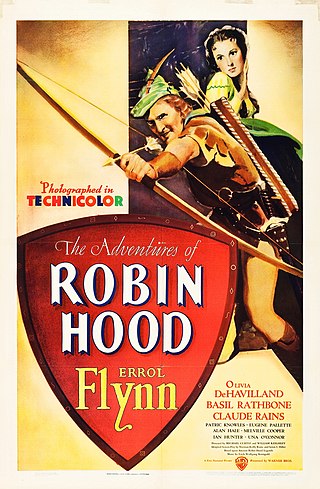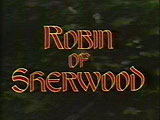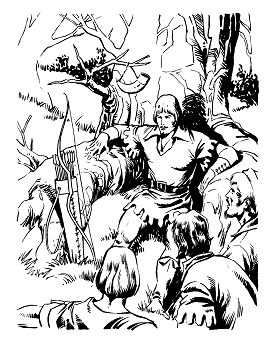
Robin Hood is a legendary heroic outlaw originally depicted in English folklore and subsequently featured in literature, theatre, and cinema. He stole from the rich and gave to the poor. According to legend, he was a highly skilled archer and swordsman. In some versions of the legend, he is depicted as being of noble birth, and in modern retellings he is sometimes depicted as having fought in the Crusades before returning to England to find his lands taken by the Sheriff. In the oldest known versions, he is instead a member of the yeoman class. He is traditionally depicted dressed in Lincoln green.

The Adventures of Robin Hood is a 1938 American epic swashbuckler film from Warner Bros. Pictures. It was produced by Hal B. Wallis and Henry Blanke, directed by Michael Curtiz and William Keighley, and written by Norman Reilly Raine and Seton I. Miller. It stars Errol Flynn as the legendary Saxon knight Robin Hood, who in Richard I's absence in the Holy Land during the Crusades, fights back as the outlaw leader of a rebel guerrilla band against Prince John and the Norman lords oppressing the Saxon commoners. The cast also includes Olivia de Havilland, Basil Rathbone, Claude Rains, Patric Knowles, Eugene Pallette, and Alan Hale.

Robin of Sherwood is a British television series, based on the legend of Robin Hood. Created by Richard Carpenter, it was produced by HTV in association with Goldcrest, and ran from 28 April 1984 to 28 June 1986 on the ITV network. In the United States it was shown on the premium cable TV channel Showtime and, later, on PBS. It was also syndicated in the early 1990s under the title Robin Hood. The show starred Michael Praed and Jason Connery as two different incarnations of the title character. Unlike previous adaptations of the Robin Hood legend, Robin of Sherwood combined a gritty, authentic production design with elements of real-life history, 20th-century fiction, and pagan myth. Robin of Sherwood has been described by historian Stephen Knight as "the most innovative and influential version of the myth in recent times". The series is also notable for its musical score by Clannad, which won a BAFTA award. A video game adaptation, Robin of Sherwood: The Touchstones of Rhiannon, was released in 1985. The series attained cult status worldwide.

Little John is a companion of Robin Hood who serves as his chief lieutenant and second-in-command of the Merry Men. He is one of only a handful of consistently named characters who relate to Robin Hood and one of the two oldest Merry Men, alongside Much the Miller's Son. His name is an ironic reference to his giant frame, as he is usually portrayed in legend as a huge warrior – a 7-foot-tall (2.1-metre) master of the quarterstaff. In folklore, he fought Robin Hood on a tree bridge across a river on their first meeting.

Maid Marian is the heroine of the Robin Hood legend in English folklore, often taken to be his lover. She is not mentioned in the early, medieval versions of the legend, but was the subject of at least two plays by 1600. Her history and circumstances are obscure, but she commanded high respect in Robin’s circle for her courage and independence as well as her beauty and loyalty. For this reason, she is celebrated by feminist commentators as one of the early strong female characters in English literature.

Conquests of the Longbow: The Legend of Robin Hood is a graphic adventure game designed by Christy Marx and published by Sierra On-Line in 1991. It is the second and final part of the Conquests series, which begins with Conquests of Camelot: The Search for the Grail. It features VGA graphics and Sierra's standard icon-driven interface first seen in King's Quest V.
Alan-a-Dale is a figure in the Robin Hood legend. According to the stories, he was a wandering minstrel who became a member of Robin's band of outlaws, the "Merry Men".

The folkloric hero Robin Hood has appeared many times, in many different variations, in popular modern works.

The Merry Men are the group of outlaws who follow Robin Hood in English literature and folklore. The group appears in the earliest ballads about Robin Hood and remains popular in modern adaptations.

Bows Against the Barons is a 1934 children's novel by the British author Geoffrey Trease, based on the legend of Robin Hood. It tells the story of an adolescent boy who joins an outlaw band and takes part in a great rebellion against the feudal elite. Trease's first novel, Bows Against the Barons marks the start of his prolific career as a historical novelist. It is notable for reinterpreting the Robin Hood legend and revitalizing the conventions of children's historical fiction in 20th-century Britain.

Richard I of England has been depicted many times in romantic fiction and popular culture.

John of England has been portrayed many times in fiction, generally reflecting the overwhelmingly negative view of his reputation.

The Outlaws of Sherwood is a retelling of the legend of Robin Hood by Robin McKinley. In McKinley's afterword, she says, "The retellings through the centuries have echoed concurrent preoccupations." The story includes both the traditional Robin Hood characters — Little John, Much, Friar Tuck, Marian and Alan-a-dale — and characters of McKinley's own invention. Notably, three of the most important characters are women, all of whom escape marriage to prospective spouses chosen by their fathers.

Friar Tuck is one of the Merry Men, the band of heroic outlaws in the folklore of Robin Hood.

Angus Donald is a British writer of historical fiction. As of 2020, he has released ten novels and three novellas that loosely follow the story of Alan-a-Dale.

Outlaw is the first novel of the eight-part Outlaw Chronicles series by British writer of historical fiction, Angus Donald, released on 10 July 2009 through Little, Brown and Company. The début novel was relatively well received.

King's Man is the third novel of the eight-part Outlaw Chronicles series by British writer of historical fiction Angus Donald, released on 21 July 2011 through Little, Brown and Company.

Lady of the Forest: A Novel of Sherwood is a 1992 historical fiction novel by American author Jennifer Roberson. A re-telling of the Robin Hood legend from the perspective of twelve characters associated with the legend, the story centers around English noblewoman Lady Marian FitzWalter's encounters with Lord Robert of Locksley and his scheming rival the Sheriff of Nottingham amid the backdrop of Prince John's schemes – he aims to increase his own wealth and power at the expense of post-Conquest England and his brother, King Richard.

The Last Arrow is a 1997 historical novel by Canadian author Marsha Canham, the third instalment of her "Medieval" trilogy inspired by the Robin Hood legend set in 13th-century England. The novel was published by Dell Publishing in 1997 as a sequel to Canham's 1994 story In the Shadow of Midnight. It received generally positive reviews from book critics.

















